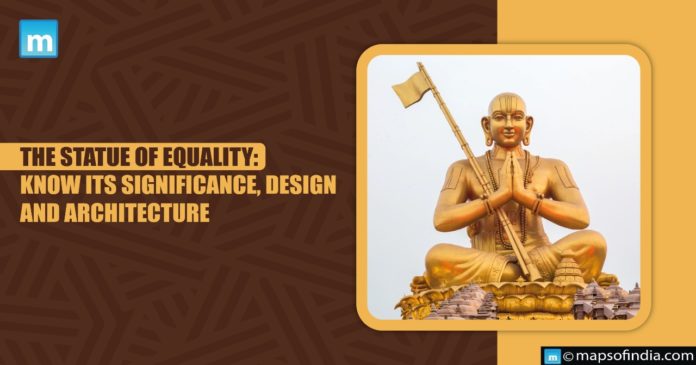The Statue of Equality, also referred as the Ramanuja monument, is a memorial to the 11th-century Vaishnavite Ramanuja that can be seen on the grounds of the Chinna Jeeyar Trust in Hyderabad.
Interestingly, it is the world’s 2nd highest statue in the sitting posture. The trust devised the statue idea to honour the 1000th anniversary of Ramanuja’s birth. Moreover, the installation, which cost an estimated 1,000 crore, was primarily funded through devotee contributions.
The monument rests atop a 54-foot-tall foundation structure called “Bhadra Vedi”. It comprises many levels dedicated to a Vedic digital library and research center, ancient Indian manuscripts, a theatre, and a collection of works by Sri Ramanujacharya, displayed as part of an educational exhibition.
Who was Ramanujacharya?
- Ramanujacharya, born in Sriperumbudur, Tamil Nadu, in 1017, is regarded as a Vedic scholar and social reformer.
- At the moment of his birth, he was given the name Lakshmana. Ilaya Perumal, “the shining one”, was also given to him.
- He toured India, fighting for social justice and equality.
- He revitalised the Bhakti movement, and his sermons influenced other Bhakti philosophers. He is an inspiration to poets like Bhakta Ramdas, Thyagaraja, Annamacharya, Kabir, and Meerabai.
- He is well known as the founder of the Vishishtadvaita subschool of Vedanta.
- VishishtAdvaita is a non-dualistic philosophical followed by the follower of Vedanta school of Philosophy.
- It is the non-dualism of the conditioned whole, in which Brahman is recognised as the Supreme Reality alone but is marked by diversity.
- He went on to create the Navaratnas, or nine texts, as well as various comments on Vedic writings.
- His commentary on the Vedic Sutras, i.e. the Sri Bhasya, and his commentary on the Bhagavad-Gita, i.e. the Gita Bhasya, are among Ramanuja’s most notable works.
Design and Architecture
- In 2014, ascetic Chinna Jeeyar proposed erecting a monument to mark the 1000th anniversary of Ramanuja’s beliefs.
- Ramanuja’s life and ideas will be shown on the bottom level, which will be 6,000 square meters. The temple, which will be used for daily worship, will be placed on the second level, which will measure 27,870 square meters. The third story, measuring 1,365 square meters, will include a Vedic digital archive and research centre.
- Consequently, Chinna Jeeyar placed the foundation stone for the statue. The monument was supposed to be finished by November 2017, but that date was later postponed to February 2019.
- Aerosun Corporation, a Nanjing-based corporation, was chosen in August 2015 to build the monument. The completed design model was 3D scanned and submitted to Aerosun Corporation for construction.
- The statue was built with 700 tons of panchaloha, a five-metal amalgam comprising silver, copper, gold, brass, and zinc. It was made in China and brought to India in 1,600 separate components via Chennai Port in 54 trips.
- On-site assembly was performed by around 60 Chinese professionals, including labourers, engineers, and welders. The assembly took fifteen months to complete between 2017 and 2018.
Why is it known as the Statue of Equality?
- Ramanuja was a centuries-old champion for social equality among all sections of society. He pushed temples to open doors to everyone, regardless of caste or social status, when many castes and social classes were barred from accessing them.
- He mission is to brought education and awareness to people who did not have chance to have it. His most remarkable contribution was promoting the value of “Vasudhaiva Kutumbakam”, which literally means “the entire universe is one family”.
- For decades, he toured across India, preaching his beliefs in social equality and global oneness from temple podiums.
- He advocated for the socially disadvantaged and stigmatised and requested that royal courts consider them equals.
- He preached global redemption via God-centered devotion, humility, equality, compassion, and mutual respect, termed the Sri Vaishnavam Sampradaya.
- With the fundamental concept that every human being is equal irrespective of nationality, gender, caste, or religious faith. Ramanujacharya set free millions from cultural, social, educational, and economic oppression.




